Sky Lagoon vs Blue Lagoon - Your Guide
Find out which one is best for you
14. nóvember 2024
Sky Lagoon vs Blue Lagoon - Your Guide
Find out which one is best for you
14. nóvember 2024
Iceland has around 45 natural hot springs and over 100 swimming pools for a population of just over 350,000 people. The Blue Lagoon with its photogenic milky-blue water and lava field surroundings has long held the title of Iceland’s most popular geothermal bath. In 2021 the Sky Lagoon was created, jutting out above the Atlantic Ocean with an undeniably beautiful view to the horizon.
So, which is better – the Blue Lagoon or the Sky Lagoon? We’ve hashed it out for you, but if you want to visit and compare the two yourself, perhaps join one of our Iceland hot spring tours.
Lagoon Locations
The Blue Lagoon is out on the Reykjanes Peninsula, about 50 kilometres (31 miles) from Reykjavik. Surrounded by moss-speckled lava fields, it feels truly other-worldly. One of the best things about The Blue Lagoon’s location is its proximity to Keflavik Airport – around 20 kilometres (12 miles) – so you can enjoy a relaxing soak straight from your flight before heading into Reykjavik.
Or, you can end your Icelandic adventure with a spa session before you catch your flight home. It is easy to combine a Blue Lagoon tour with an airport transfer from Reykjavik to Keflavik.
The Sky Lagoon can be found on the outskirts of Reykjavik, around 7 kilometres (4 miles) from the city centre. Sky Lagoon tours from the centre can see you at the baths in just fifteen minutes by car.
The view from the bath-warm water of the Sky Lagoon is simply sublime as it juts out over the wild North Atlantic Sea, taking in the black lava rocks of Iceland’s coastline. It is particularly beautiful at sunset when the sea shimmers gold.
So, choosing between the Blue Lagoon and the Sky Lagoon in terms of location depends on whether you want a view of the ocean or a view of the other-worldly lava fields of Iceland’s iconic landscape. Or whether you want to combine your lagoon trip with an airport transfer.
Facts About the Lagoons
Iceland’s most famous geothermal spa, The Blue Lagoon holds around 9 million litres of heated water and stretches over a surface area of 8,700 square metres. It’s the largest man-made mineral bath in the world. That’s right, it is man-made, formed by the natural run-off water from a nearby power plant.
It’s worth noting that the run-off water is from a geothermal power plant, so it is naturally heated and the milky-blue appearance is not due to chemicals but because of natural minerals in the water, like silica. You’re not going to grow an extra toe or gain superpowers by bathing in the Blue Lagoon!
The Blue Lagoon is by far Iceland’s most popular attraction with around 80% of visitors to the country stopping for a soak. It sees over a million visitors every year – that’s around three times the population of Iceland.
At the beginning of the year (January to May), the Blue Lagoon is open between 08.00 and 22.00, so you have a chance to see the Northern Lights after sunset. In the months of the midnight sun (June, July and August) the lagoon is open between 07.00 and 24.00 with an additional hour for the summer solstice. For the remainder of the year, it stays open between 08.00 to 22.00 with early closing on Christmas Eve and New Year’s Eve.
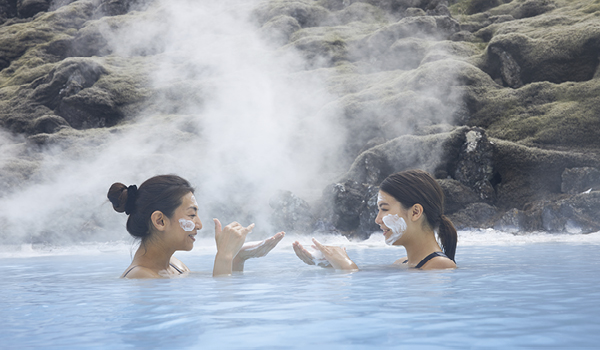
Iceland’s newest man-made lagoon, The Sky Lagoon opened in 2021 and expanded with a larger ritual area in 2024. It is naturally heated by geothermal activity, just like the Blue Lagoon and even though it is man-made, there’s an ancient feel to the grottos and curvy stone infinity pool that looks out over the steely Atlantic Ocean.
At its deepest point, it is almost five feet deep, so although you can technically swim a few leisurely breaststrokes, it is really designed for soaking and floating while you take in Iceland’s rugged scenery.
The Sky Lagoon has shorter opening hours than The Blue Lagoon, and exact hours vary by day of the week so it is always best to check their website before visiting. Generally, between September and May, the lagoon is open from 11.00 to 22.00 with additional extra hours on Fridays and Saturdays. In the height of summer, it is open between 08.00 and 23.00, taking advantage of the longer days.
Enjoy a day of wonders and wellness on The Golden Circle with a stop at the Fontana Spa
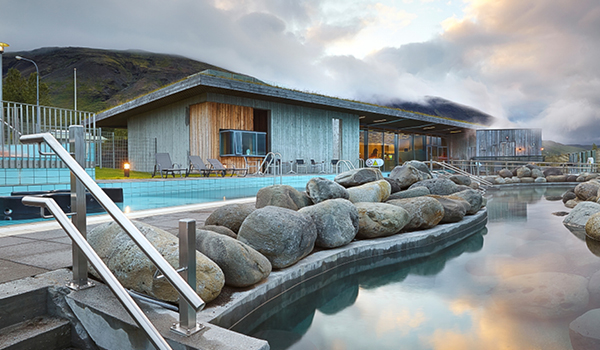
Pair a day of sightseeing around Iceland’s most famous natural wonders – the thundering falls of Gullfoss, the chasm between the continental plates at Þingvellir and the geothermal eruption of Stokur – with a soothing spa session on our Golden Circle and Fontana Spa tour.
The History of the Lagoons
While the lava field around the Blue Lagoon is over 800 years old, the lagoon itself was created in the 1970s using excess water from a nearby power plant. In the early 1980s, locals began bathing in the geothermally heated run-off and realized that the mineral-rich water cured skin irritations such as psoriasis and left their skin soft and supple. By 1992, changing rooms and showers had been added, and The Blue Lagoon Company began trading.
At the end of the 1990s, the power plant moved location, and with it, the Blue Lagoon relocated to its current spot in the heart of the Svartsengi lava field. Brand new changing facilities, restaurants, and spa treatments were added to the site for the luxurious experience you see today.
Located on an isolated peninsula, there are plenty of other things to see and do around the Blue Lagoon – explore this rugged hinterland on a Reykjanes tour. Recently, volcanic activity has increased on the Reykjanes Peninsula, prompting the Blue Lagoon to close briefly during eruptions as a precaution. However, it typically reopens shortly afterward, and despite eruptions occurring nearby, there have been no incidents affecting the lagoon or its visitors.
Although the Sky Lagoon was only recently built in 2021, its design pays homage to Iceland’s deep-rooted bathing traditions with its iconic turf-roofed huts. These huts are a nod to the communal bathing culture dating back to the time of the Icelandic Sagas, when people would gather in outdoor pools across lakes and rivers for warmth, relaxation, and social connection.
Sky Lagoon also embraces the ancient Icelandic art of sauna, a tradition that began in the 16th century. Early Icelanders would sit in huts built over natural lava seams, using the earth’s geothermal heat as a source of warmth and cleansing. In 2024, Sky Lagoon expanded its Ritual area, now offering two saunas, including a unique ‘off-line’ sauna with a no-phone policy, inviting guests to disconnect and fully immerse themselves in the experience.
Adding to the allure, volcanic eruptions have occasionally been visible from Sky Lagoon, providing a front-row seat to Iceland’s raw volcanic power. From a safe distance, guests can observe smoking lava fields and the evolving landscape, making the lagoon a perfect vantage point for witnessing Iceland’s dynamic natural beauty.
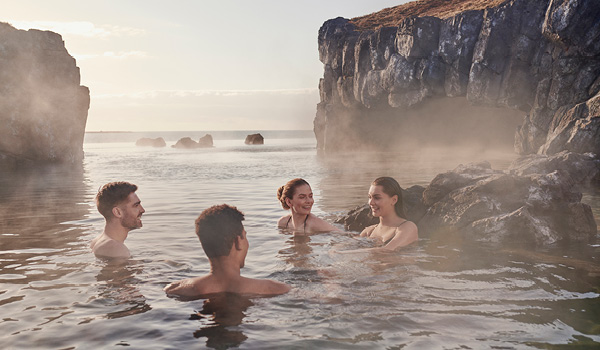
The Geothermal Water
Iceland’s geothermal water is used to heat houses, power homes and even bake bread. Both the Blue Lagoon and Sky Lagoon are heated naturally by geothermal water. The Blue Lagoon tends to stay between 37° and 40° C (98 and 104°F), while the Sky Lagoon is similar, between 38 and 40°C (or 100 to 104° F).
The naturally warmed water, pumped from deep within the earth into the Sky Lagoon, is actually far too hot to bathe in, so it is combined with cold water to reach the bath-like temperature that makes it an enjoyable experience.
You can experience all kinds of Iceland’s water on a Blue Lagoon combo tour, combining a session at the lagoon with sightseeing at Gullfoss and Geysir area of geothermal activity along the Golden Circle. Or, perhaps experience Iceland’s latest luxury lagoon alongside the Golden Circle wonders on a Sky Lagoon combo tour.
Soak in geothermal baths floating serenely in a lake at Vök Baths.
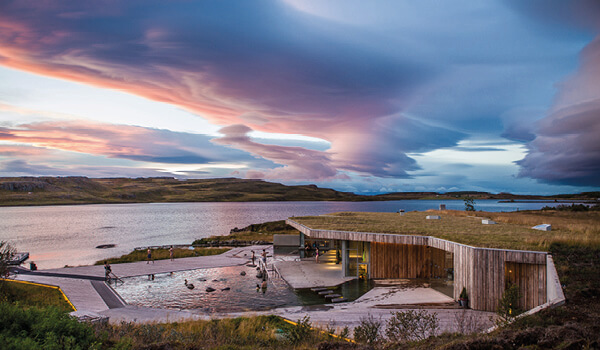
In East Iceland’s Lake Urriðavatn, you’ll find two geothermal pools fit for bathing. The water in the pools is so pure, it is the only hot spring in Iceland with certifiable drinking water. The surroundings are beautiful, so enjoy the view with arranged admission to Vök Baths.
Lagoon Admission Fees
If you are visiting the Blue Lagoon yourself, the most basic admission is the “comfort” tier and starts at around £56 ($72) which includes entrance to the lagoon, changing facilities and showers, a silica mud mask, use of a towel and one free drink.
There are also premium options and luxury options with additional perks. We offer comfort-level Blue Lagoon admission paired with transfers from Reykjavik city centre for your convenience.
Sky Lagoon admission prices begin at £59 ($75), which includes admission to the lagoon, changing facilities and the use of a towel and asmission to the Skjól Ritual. Upgrade is available with private changing facilities, platters from the Smakk bar and admission packages for two.
Our Sky Lagoon pass options include the Skjól ritual – soaking in the hot-tub-warm main lagoon, plunging into the ice-cold glacier pool, warming up again in the sauna with a sea view, refreshing under the mist showers, exfoliating with the Sky Body Scrub, opening up the pores in the steam room, and finally, tasting a local resipe crowberries essence elixir.
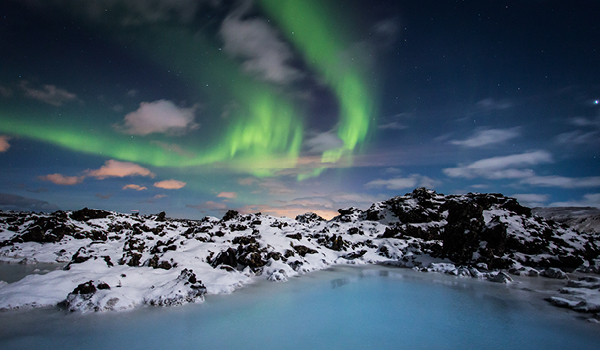
Dining at the Lagoons
The Sky Lagoon has a couple of dining options to satisfy your taste buds and refuel between spa sessions. The Sky Café offers simple fare such as sandwiches, hearty soups and smoked salmon plates.
For a more refined experience, the Smakk Bar serves five different tasting platters, taking you on a gastronomic journey across Iceland with a selection of locally-sourced cheeses, cured meats and bread. You could easily spend all day here with our Sky Lagoon admission which includes transfers.
With three high-end restaurants, the dining scene at The Blue Lagoon may be the factor that persuades foodies in its favour. The Spa Restaurant is the most laid-back of the three – you can even show up in your bathrobe straight from a massage or treatment – and serves an array of warm dishes like hearty soups and healthy cold numbers like fresh fish ceviche.
Making a reservation isn’t necessary at The Spa Restaurant. The interior of Lava Restaurant is carved into the side of a rock, creating an atmospheric space to dine. It’s all about Iceland’s locally-sourced ingredients here with the fish of the day landed at Grindavik harbour.
Finally, Moss is the ultra fine-dining option. It is even mentioned in the Michelin Guide. Think seasonal tasting menus prepared with precision and finesse and served to views over the lava fields.
There’s even a luxurious hotel at the Blue Lagoon with its own subterranean spa using the milky-blue waters in its treatments. Some of the plushest suites come with access to private lagoons right outside the door.
So, Blue Lagoon or Sky Lagoon, who is the winner?
Of course, which lagoon is better depends on your own personal preferences and tastes. If you prefer a sea view as you soak in the warm water of Iceland’s geothermal baths, then the Sky Lagoon is for you. But if it is Iceland’s unique lava landscape you prefer to gaze at while you don a mud mask and sip sparkling wine, then it has to be the Blue Lagoon.
If you want to combine your lagoon experience with an airport transfer, then stopping off at the Blue Lagoon is convenient due to its close proximity to Keflavik Airport. But the Sky Lagoon is only a fifteen-minute drive from the centre of Reykjavik, so an easy addition to a day of sightseeing in the city.
Bathe in water from Europe’s most powerful hotspring at Krauma Natural Geothermal Baths & Spa
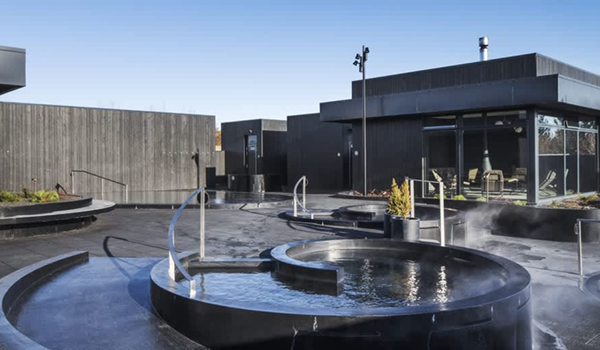
Five natural geothermal baths, twisted like snail’s shells, await at Krauma Spa on Iceland’s western peninsula. On a Krauma spa tour you can soak in the outdoor baths – a temperate mixture of boiling-hot water from the Deildartunguhver spring and cold glacial water from Rauðsgil.
Frequently Asked Questions
Which one is better – Blue Lagoon or Sky Lagoon?
Which lagoon is better depends on your personal preferences – the kind of landscape you like, whether you want to fit in a spa session with an airport transfer or just make a short hop from Reykjavik. Those that prefer a sea view should opt for the Sky Lagoon, while the Blue Lagoon is surrounded by lava fields. The Sky Lagoon is a short, fifteen-minute drive from the centre of Reykjavik, whereas the Blue Lagoon is further away (around a 45-minute drive from Reykjavik) but is close to Keflavik Airport so you can indulge in a soak pre or post-flight.
Are the Blue Lagoon and Sky Lagoon the same thing?
Although they are both geothermally heated outdoor bathing experiences, the Blue Lagoon and Sky Lagoon are not the same. The Blue Lagoon is out on the Reykjanes peninsula, around 50 kilometres from Reykjavik, whereas the Sky Lagoon is only 7 kilometres outside the centre of Reykjavik. While the Sky Lagoon’s water is clear, reflecting the mood of the sky, the Blue Lagoon features ethereal milky-blue water that looks as though it belongs on another planet.
Which lagoon is best in Iceland?
You’ll find geothermal lagoons and pools scattered across the rugged landscape – in rivers, floating within lakes and hidden in rocky valleys. The Blue Lagoon is the biggest and most popular lagoon in Iceland, but the Sky Lagoon only opened in 2021 and is fast becoming a favourite with locals and visitors alike.
Is the Sky Lagoon in Iceland worth it?
With a stunning sea view, spa rituals steeped in Icelandic tradition and an aesthetic of mediaeval northern Europe, the Sky Lagoon is definitely worth it. The most basic entry fee includes admission to the lagoon, changing rooms and the use of a towel. You can upgrade to experience the seven-step ritual, embracing the warm lagoon, glacier plunge pool, sauna and exfoliating scrub.
Can you get food at the Blue Lagoon?
There are three restaurants at the Blue Lagoon for various budgets and dining style. A casual spa café provides hearty and healthy lunches, while the Lava restaurant offers upscale dining throughout the day and evening and Moss has earned a spot in the Michelin Guide for its lavish tasting menus featuring fine Icelandic cuisine.
So, the winner of the Blue Lagoon vs Sky Lagoon face-off depends on your preferences. You can decide which to visit based on location – the seafront Sky Lagoon hanging on a cliff above the Atlantic, or the Blue Lagoon surrounded by an 800-year-old lava field.
Or, you can decide based on your itinerary. The Blue Lagoon fits perfectly with airport transfers, and the Sky Lagoon is ideal after a day of sightseeing in the capital. Maybe the answer is to visit both for the full experience. We offer admission to the Sky Lagoon and Blue Lagoon so you can compare the experiences yourself.
Áhugaverðar ferðir
Blogg
Fáðu innblástur! Upplýsingar og góð ráð, áhugaverðir áfangastaðir, skemmtilegar staðreyndar og margt fleira. Bloggið okkar er á ensku en það er stórskemmtilegt engu að síður!
The Silver Circle of West Iceland - Your Guide
You’ve heard of the Golden Circle, but here’s why you should head to Iceland’s western region to explore the msytical Silver Circle tour route.
Lesa bloggSky Lagoon vs Blue Lagoon - Your Guide
Find out which one is best for you
14. nóvember 2024
Sky Lagoon vs Blue Lagoon - Your Guide
Find out which one is best for you
14. nóvember 2024
Iceland has around 45 natural hot springs and over 100 swimming pools for a population of just over 350,000 people. The Blue Lagoon with its photogenic milky-blue water and lava field surroundings has long held the title of Iceland’s most popular geothermal bath. In 2021 the Sky Lagoon was created, jutting out above the Atlantic Ocean with an undeniably beautiful view to the horizon.
So, which is better – the Blue Lagoon or the Sky Lagoon? We’ve hashed it out for you, but if you want to visit and compare the two yourself, perhaps join one of our Iceland hot spring tours.
Lagoon Locations
The Blue Lagoon is out on the Reykjanes Peninsula, about 50 kilometres (31 miles) from Reykjavik. Surrounded by moss-speckled lava fields, it feels truly other-worldly. One of the best things about The Blue Lagoon’s location is its proximity to Keflavik Airport – around 20 kilometres (12 miles) – so you can enjoy a relaxing soak straight from your flight before heading into Reykjavik.
Or, you can end your Icelandic adventure with a spa session before you catch your flight home. It is easy to combine a Blue Lagoon tour with an airport transfer from Reykjavik to Keflavik.
The Sky Lagoon can be found on the outskirts of Reykjavik, around 7 kilometres (4 miles) from the city centre. Sky Lagoon tours from the centre can see you at the baths in just fifteen minutes by car.
The view from the bath-warm water of the Sky Lagoon is simply sublime as it juts out over the wild North Atlantic Sea, taking in the black lava rocks of Iceland’s coastline. It is particularly beautiful at sunset when the sea shimmers gold.
So, choosing between the Blue Lagoon and the Sky Lagoon in terms of location depends on whether you want a view of the ocean or a view of the other-worldly lava fields of Iceland’s iconic landscape. Or whether you want to combine your lagoon trip with an airport transfer.
Facts About the Lagoons
Iceland’s most famous geothermal spa, The Blue Lagoon holds around 9 million litres of heated water and stretches over a surface area of 8,700 square metres. It’s the largest man-made mineral bath in the world. That’s right, it is man-made, formed by the natural run-off water from a nearby power plant.
It’s worth noting that the run-off water is from a geothermal power plant, so it is naturally heated and the milky-blue appearance is not due to chemicals but because of natural minerals in the water, like silica. You’re not going to grow an extra toe or gain superpowers by bathing in the Blue Lagoon!
The Blue Lagoon is by far Iceland’s most popular attraction with around 80% of visitors to the country stopping for a soak. It sees over a million visitors every year – that’s around three times the population of Iceland.
At the beginning of the year (January to May), the Blue Lagoon is open between 08.00 and 22.00, so you have a chance to see the Northern Lights after sunset. In the months of the midnight sun (June, July and August) the lagoon is open between 07.00 and 24.00 with an additional hour for the summer solstice. For the remainder of the year, it stays open between 08.00 to 22.00 with early closing on Christmas Eve and New Year’s Eve.

Iceland’s newest man-made lagoon, The Sky Lagoon opened in 2021 and expanded with a larger ritual area in 2024. It is naturally heated by geothermal activity, just like the Blue Lagoon and even though it is man-made, there’s an ancient feel to the grottos and curvy stone infinity pool that looks out over the steely Atlantic Ocean.
At its deepest point, it is almost five feet deep, so although you can technically swim a few leisurely breaststrokes, it is really designed for soaking and floating while you take in Iceland’s rugged scenery.
The Sky Lagoon has shorter opening hours than The Blue Lagoon, and exact hours vary by day of the week so it is always best to check their website before visiting. Generally, between September and May, the lagoon is open from 11.00 to 22.00 with additional extra hours on Fridays and Saturdays. In the height of summer, it is open between 08.00 and 23.00, taking advantage of the longer days.
Enjoy a day of wonders and wellness on The Golden Circle with a stop at the Fontana Spa

Pair a day of sightseeing around Iceland’s most famous natural wonders – the thundering falls of Gullfoss, the chasm between the continental plates at Þingvellir and the geothermal eruption of Stokur – with a soothing spa session on our Golden Circle and Fontana Spa tour.
The History of the Lagoons
While the lava field around the Blue Lagoon is over 800 years old, the lagoon itself was created in the 1970s using excess water from a nearby power plant. In the early 1980s, locals began bathing in the geothermally heated run-off and realized that the mineral-rich water cured skin irritations such as psoriasis and left their skin soft and supple. By 1992, changing rooms and showers had been added, and The Blue Lagoon Company began trading.
At the end of the 1990s, the power plant moved location, and with it, the Blue Lagoon relocated to its current spot in the heart of the Svartsengi lava field. Brand new changing facilities, restaurants, and spa treatments were added to the site for the luxurious experience you see today.
Located on an isolated peninsula, there are plenty of other things to see and do around the Blue Lagoon – explore this rugged hinterland on a Reykjanes tour. Recently, volcanic activity has increased on the Reykjanes Peninsula, prompting the Blue Lagoon to close briefly during eruptions as a precaution. However, it typically reopens shortly afterward, and despite eruptions occurring nearby, there have been no incidents affecting the lagoon or its visitors.
Although the Sky Lagoon was only recently built in 2021, its design pays homage to Iceland’s deep-rooted bathing traditions with its iconic turf-roofed huts. These huts are a nod to the communal bathing culture dating back to the time of the Icelandic Sagas, when people would gather in outdoor pools across lakes and rivers for warmth, relaxation, and social connection.
Sky Lagoon also embraces the ancient Icelandic art of sauna, a tradition that began in the 16th century. Early Icelanders would sit in huts built over natural lava seams, using the earth’s geothermal heat as a source of warmth and cleansing. In 2024, Sky Lagoon expanded its Ritual area, now offering two saunas, including a unique ‘off-line’ sauna with a no-phone policy, inviting guests to disconnect and fully immerse themselves in the experience.
Adding to the allure, volcanic eruptions have occasionally been visible from Sky Lagoon, providing a front-row seat to Iceland’s raw volcanic power. From a safe distance, guests can observe smoking lava fields and the evolving landscape, making the lagoon a perfect vantage point for witnessing Iceland’s dynamic natural beauty.

The Geothermal Water
Iceland’s geothermal water is used to heat houses, power homes and even bake bread. Both the Blue Lagoon and Sky Lagoon are heated naturally by geothermal water. The Blue Lagoon tends to stay between 37° and 40° C (98 and 104°F), while the Sky Lagoon is similar, between 38 and 40°C (or 100 to 104° F).
The naturally warmed water, pumped from deep within the earth into the Sky Lagoon, is actually far too hot to bathe in, so it is combined with cold water to reach the bath-like temperature that makes it an enjoyable experience.
You can experience all kinds of Iceland’s water on a Blue Lagoon combo tour, combining a session at the lagoon with sightseeing at Gullfoss and Geysir area of geothermal activity along the Golden Circle. Or, perhaps experience Iceland’s latest luxury lagoon alongside the Golden Circle wonders on a Sky Lagoon combo tour.
Soak in geothermal baths floating serenely in a lake at Vök Baths.

In East Iceland’s Lake Urriðavatn, you’ll find two geothermal pools fit for bathing. The water in the pools is so pure, it is the only hot spring in Iceland with certifiable drinking water. The surroundings are beautiful, so enjoy the view with arranged admission to Vök Baths.
Lagoon Admission Fees
If you are visiting the Blue Lagoon yourself, the most basic admission is the “comfort” tier and starts at around £56 ($72) which includes entrance to the lagoon, changing facilities and showers, a silica mud mask, use of a towel and one free drink.
There are also premium options and luxury options with additional perks. We offer comfort-level Blue Lagoon admission paired with transfers from Reykjavik city centre for your convenience.
Sky Lagoon admission prices begin at £59 ($75), which includes admission to the lagoon, changing facilities and the use of a towel and asmission to the Skjól Ritual. Upgrade is available with private changing facilities, platters from the Smakk bar and admission packages for two.
Our Sky Lagoon pass options include the Skjól ritual – soaking in the hot-tub-warm main lagoon, plunging into the ice-cold glacier pool, warming up again in the sauna with a sea view, refreshing under the mist showers, exfoliating with the Sky Body Scrub, opening up the pores in the steam room, and finally, tasting a local resipe crowberries essence elixir.

Dining at the Lagoons
The Sky Lagoon has a couple of dining options to satisfy your taste buds and refuel between spa sessions. The Sky Café offers simple fare such as sandwiches, hearty soups and smoked salmon plates.
For a more refined experience, the Smakk Bar serves five different tasting platters, taking you on a gastronomic journey across Iceland with a selection of locally-sourced cheeses, cured meats and bread. You could easily spend all day here with our Sky Lagoon admission which includes transfers.
With three high-end restaurants, the dining scene at The Blue Lagoon may be the factor that persuades foodies in its favour. The Spa Restaurant is the most laid-back of the three – you can even show up in your bathrobe straight from a massage or treatment – and serves an array of warm dishes like hearty soups and healthy cold numbers like fresh fish ceviche.
Making a reservation isn’t necessary at The Spa Restaurant. The interior of Lava Restaurant is carved into the side of a rock, creating an atmospheric space to dine. It’s all about Iceland’s locally-sourced ingredients here with the fish of the day landed at Grindavik harbour.
Finally, Moss is the ultra fine-dining option. It is even mentioned in the Michelin Guide. Think seasonal tasting menus prepared with precision and finesse and served to views over the lava fields.
There’s even a luxurious hotel at the Blue Lagoon with its own subterranean spa using the milky-blue waters in its treatments. Some of the plushest suites come with access to private lagoons right outside the door.
So, Blue Lagoon or Sky Lagoon, who is the winner?
Of course, which lagoon is better depends on your own personal preferences and tastes. If you prefer a sea view as you soak in the warm water of Iceland’s geothermal baths, then the Sky Lagoon is for you. But if it is Iceland’s unique lava landscape you prefer to gaze at while you don a mud mask and sip sparkling wine, then it has to be the Blue Lagoon.
If you want to combine your lagoon experience with an airport transfer, then stopping off at the Blue Lagoon is convenient due to its close proximity to Keflavik Airport. But the Sky Lagoon is only a fifteen-minute drive from the centre of Reykjavik, so an easy addition to a day of sightseeing in the city.
Bathe in water from Europe’s most powerful hotspring at Krauma Natural Geothermal Baths & Spa

Five natural geothermal baths, twisted like snail’s shells, await at Krauma Spa on Iceland’s western peninsula. On a Krauma spa tour you can soak in the outdoor baths – a temperate mixture of boiling-hot water from the Deildartunguhver spring and cold glacial water from Rauðsgil.
Frequently Asked Questions
Which one is better – Blue Lagoon or Sky Lagoon?
Which lagoon is better depends on your personal preferences – the kind of landscape you like, whether you want to fit in a spa session with an airport transfer or just make a short hop from Reykjavik. Those that prefer a sea view should opt for the Sky Lagoon, while the Blue Lagoon is surrounded by lava fields. The Sky Lagoon is a short, fifteen-minute drive from the centre of Reykjavik, whereas the Blue Lagoon is further away (around a 45-minute drive from Reykjavik) but is close to Keflavik Airport so you can indulge in a soak pre or post-flight.
Are the Blue Lagoon and Sky Lagoon the same thing?
Although they are both geothermally heated outdoor bathing experiences, the Blue Lagoon and Sky Lagoon are not the same. The Blue Lagoon is out on the Reykjanes peninsula, around 50 kilometres from Reykjavik, whereas the Sky Lagoon is only 7 kilometres outside the centre of Reykjavik. While the Sky Lagoon’s water is clear, reflecting the mood of the sky, the Blue Lagoon features ethereal milky-blue water that looks as though it belongs on another planet.
Which lagoon is best in Iceland?
You’ll find geothermal lagoons and pools scattered across the rugged landscape – in rivers, floating within lakes and hidden in rocky valleys. The Blue Lagoon is the biggest and most popular lagoon in Iceland, but the Sky Lagoon only opened in 2021 and is fast becoming a favourite with locals and visitors alike.
Is the Sky Lagoon in Iceland worth it?
With a stunning sea view, spa rituals steeped in Icelandic tradition and an aesthetic of mediaeval northern Europe, the Sky Lagoon is definitely worth it. The most basic entry fee includes admission to the lagoon, changing rooms and the use of a towel. You can upgrade to experience the seven-step ritual, embracing the warm lagoon, glacier plunge pool, sauna and exfoliating scrub.
Can you get food at the Blue Lagoon?
There are three restaurants at the Blue Lagoon for various budgets and dining style. A casual spa café provides hearty and healthy lunches, while the Lava restaurant offers upscale dining throughout the day and evening and Moss has earned a spot in the Michelin Guide for its lavish tasting menus featuring fine Icelandic cuisine.
So, the winner of the Blue Lagoon vs Sky Lagoon face-off depends on your preferences. You can decide which to visit based on location – the seafront Sky Lagoon hanging on a cliff above the Atlantic, or the Blue Lagoon surrounded by an 800-year-old lava field.
Or, you can decide based on your itinerary. The Blue Lagoon fits perfectly with airport transfers, and the Sky Lagoon is ideal after a day of sightseeing in the capital. Maybe the answer is to visit both for the full experience. We offer admission to the Sky Lagoon and Blue Lagoon so you can compare the experiences yourself.
Áhugaverðar ferðir
Blogg
Fáðu innblástur! Upplýsingar og góð ráð, áhugaverðir áfangastaðir, skemmtilegar staðreyndar og margt fleira. Bloggið okkar er á ensku en það er stórskemmtilegt engu að síður!
The Silver Circle of West Iceland - Your Guide
You’ve heard of the Golden Circle, but here’s why you should head to Iceland’s western region to explore the msytical Silver Circle tour route.
Lesa blogg